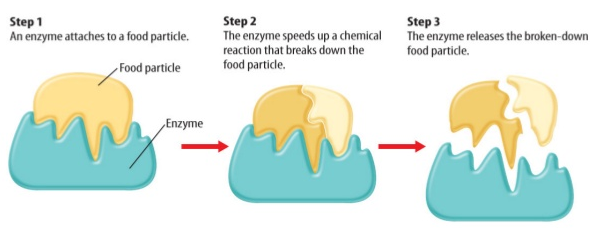Digestive enzymes work for the breakdown of the polymeric macromolecules to their smaller subunits or building blocks. In animals, they are found in their digestive tracks, and in plants, they are found in the traps, where they help in the digestion of the food. They are also found inside the cells, especially in the lysosomes, where they function for the survival of the cell. Digestive enzymes have many specificities and they are also secreted by the salivary glands, in the saliva.
Role Of Enzymes In Digestion

Note: The food molecule breaks apart, but the enzyme does not change. Therefore, the enzyme can immediately be used to break down another food molecule.
Digestive Enzymes Causes Break Down of Food
The main function of the digestive enzymes is to speed up the hydrolysis (break down) of the food molecules to their building blocks. The site for these reactions is the cell lining of the gut. Digestive enzymes are extracellular and they cause the mixing of the food when it passes through the gut. Here, the digestion of food particles is significantly dependent on the whole range of the hydrolase enzymes produced by the cell lining of the gut and the associated organs like the pancreas.
How Enzymes Works in Digestive System
Proteases are present in the intestine, stomach, and pancreas. These enzymes are proteolytic and they cause the digestion of proteins to the small units including the casein of the dairy products, and the gluten of the cereal grains. They support the intestinal balance and reduces the inflammation.
Lipases are found in the mouthparts, stomach, and in the pancreas that helps to digest the oils, and the dietary fats into the more absorbable forms.
Lactase is found in the small intestine and it converts the lactose obtained from the dairy products in the body to the absorbable forms of the sugars.
Amylases are present in the pancreas and saliva and they help to convert the glycogen, starches, and the carbohydrates obtained from the pasta and bread to the simplest sugars which can be readily absorbed.
Cellulase and Hemicellulase are found in the microflora of the gut and they convert the indigestible plant-based carbohydrates and the fibers to the simplest and the smallest molecules that can be easily processed by the body. They also help to increase the level of important nutrients such as vitamins, antioxidants, macronutrients, micronutrients, and minerals.
The conclusion is that the digestive enzymes have the significance for the optimal digestive functions, and if they are not present in the appropriate amount, they can create various challenges related to the health.